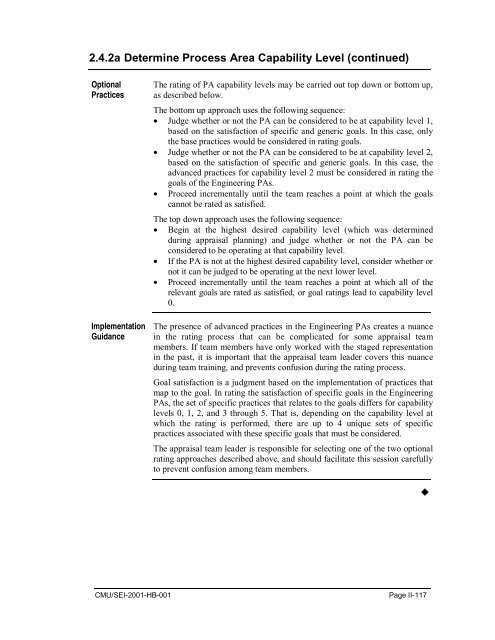Standard CMMI Appraisal Method for Process Improvement (SCAMPI)
Standard CMMI Appraisal Method for Process Improvement (SCAMPI)
Standard CMMI Appraisal Method for Process Improvement (SCAMPI)
Create successful ePaper yourself
Turn your PDF publications into a flip-book with our unique Google optimized e-Paper software.
2.4.2a Determine <strong>Process</strong> Area Capability Level (continued)<br />
Optional<br />
Practices<br />
Implementation<br />
Guidance<br />
The rating of PA capability levels may be carried out top down or bottom up,<br />
as described below.<br />
The bottom up approach uses the following sequence:<br />
• Judge whether or not the PA can be considered to be at capability level 1,<br />
based on the satisfaction of specific and generic goals. In this case, only<br />
the base practices would be considered in rating goals.<br />
• Judge whether or not the PA can be considered to be at capability level 2,<br />
based on the satisfaction of specific and generic goals. In this case, the<br />
advanced practices <strong>for</strong> capability level 2 must be considered in rating the<br />
goals of the Engineering PAs.<br />
• Proceed incrementally until the team reaches a point at which the goals<br />
cannot be rated as satisfied.<br />
The top down approach uses the following sequence:<br />
• Begin at the highest desired capability level (which was determined<br />
during appraisal planning) and judge whether or not the PA can be<br />
considered to be operating at that capability level.<br />
• If the PA is not at the highest desired capability level, consider whether or<br />
not it can be judged to be operating at the next lower level.<br />
• Proceed incrementally until the team reaches a point at which all of the<br />
relevant goals are rated as satisfied, or goal ratings lead to capability level<br />
0.<br />
The presence of advanced practices in the Engineering PAs creates a nuance<br />
in the rating process that can be complicated <strong>for</strong> some appraisal team<br />
members. If team members have only worked with the staged representation<br />
in the past, it is important that the appraisal team leader covers this nuance<br />
during team training, and prevents confusion during the rating process.<br />
Goal satisfaction is a judgment based on the implementation of practices that<br />
map to the goal. In rating the satisfaction of specific goals in the Engineering<br />
PAs, the set of specific practices that relates to the goals differs <strong>for</strong> capability<br />
levels 0, 1, 2, and 3 through 5. That is, depending on the capability level at<br />
which the rating is per<strong>for</strong>med, there are up to 4 unique sets of specific<br />
practices associated with these specific goals that must be considered.<br />
The appraisal team leader is responsible <strong>for</strong> selecting one of the two optional<br />
rating approaches described above, and should facilitate this session carefully<br />
to prevent confusion among team members.<br />
<br />
CMU/SEI-2001-HB-001<br />
Page II-117
















